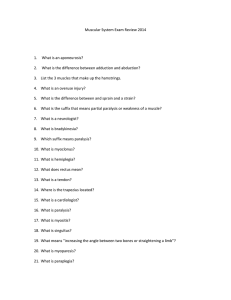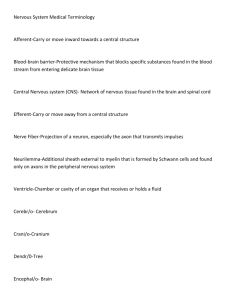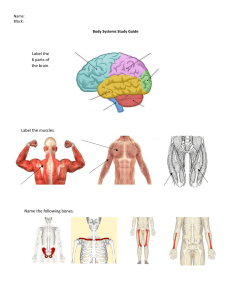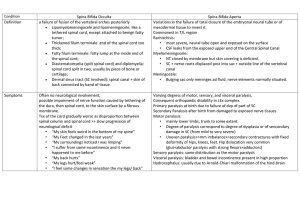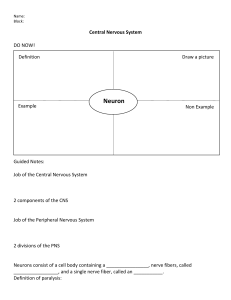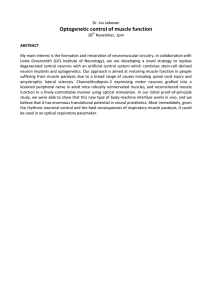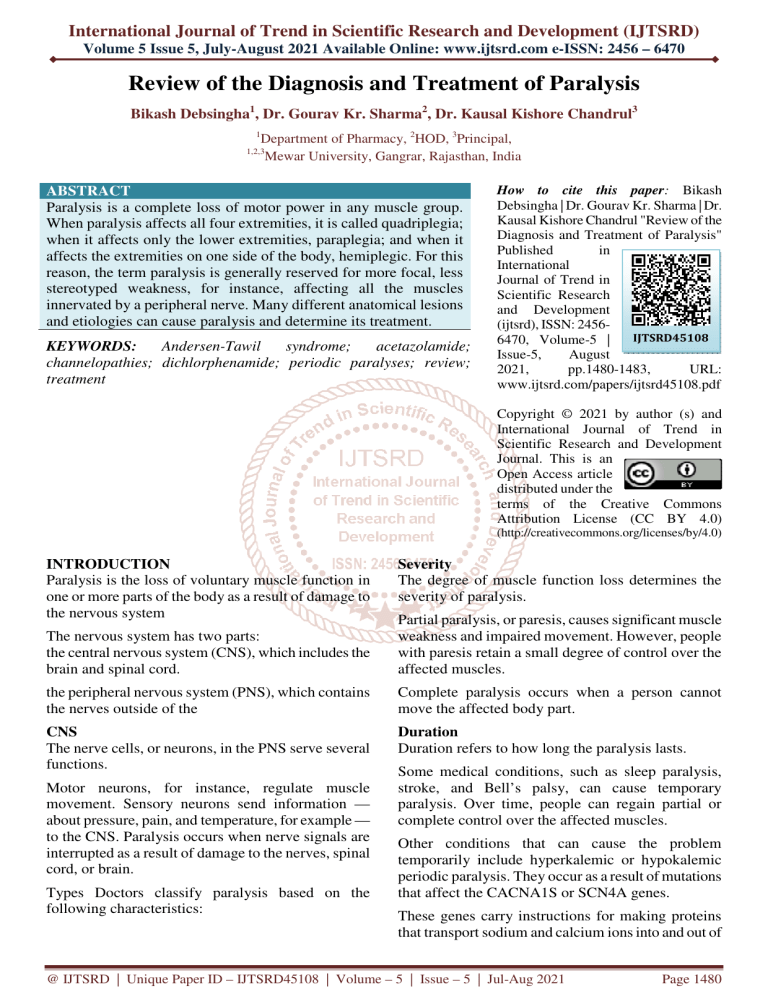
International Journal of Trend in Scientific Research and Development (IJTSRD) Volume 5 Issue 5, July-August 2021 Available Online: www.ijtsrd.com e-ISSN: 2456 – 6470 Review of the Diagnosis and Treatment of Paralysis Bikash Debsingha1, Dr. Gourav Kr. Sharma2, Dr. Kausal Kishore Chandrul3 1 Department of Pharmacy, 2HOD, 3Principal, Mewar University, Gangrar, Rajasthan, India 1,2,3 ABSTRACT Paralysis is a complete loss of motor power in any muscle group. When paralysis affects all four extremities, it is called quadriplegia; when it affects only the lower extremities, paraplegia; and when it affects the extremities on one side of the body, hemiplegic. For this reason, the term paralysis is generally reserved for more focal, less stereotyped weakness, for instance, affecting all the muscles innervated by a peripheral nerve. Many different anatomical lesions and etiologies can cause paralysis and determine its treatment. KEYWORDS: Andersen-Tawil syndrome; acetazolamide; channelopathies; dichlorphenamide; periodic paralyses; review; treatment How to cite this paper: Bikash Debsingha | Dr. Gourav Kr. Sharma | Dr. Kausal Kishore Chandrul "Review of the Diagnosis and Treatment of Paralysis" Published in International Journal of Trend in Scientific Research and Development (ijtsrd), ISSN: 2456IJTSRD45108 6470, Volume-5 | Issue-5, August 2021, pp.1480-1483, URL: www.ijtsrd.com/papers/ijtsrd45108.pdf Copyright © 2021 by author (s) and International Journal of Trend in Scientific Research and Development Journal. This is an Open Access article distributed under the terms of the Creative Commons Attribution License (CC BY 4.0) (http://creativecommons.org/licenses/by/4.0) INTRODUCTION Paralysis is the loss of voluntary muscle function in one or more parts of the body as a result of damage to the nervous system Severity The degree of muscle function loss determines the severity of paralysis. The nervous system has two parts: the central nervous system (CNS), which includes the brain and spinal cord. Partial paralysis, or paresis, causes significant muscle weakness and impaired movement. However, people with paresis retain a small degree of control over the affected muscles. the peripheral nervous system (PNS), which contains the nerves outside of the Complete paralysis occurs when a person cannot move the affected body part. CNS The nerve cells, or neurons, in the PNS serve several functions. Duration Duration refers to how long the paralysis lasts. Motor neurons, for instance, regulate muscle movement. Sensory neurons send information — about pressure, pain, and temperature, for example — to the CNS. Paralysis occurs when nerve signals are interrupted as a result of damage to the nerves, spinal cord, or brain. Types Doctors classify paralysis based on the following characteristics: Some medical conditions, such as sleep paralysis, stroke, and Bell’s palsy, can cause temporary paralysis. Over time, people can regain partial or complete control over the affected muscles. Other conditions that can cause the problem temporarily include hyperkalemic or hypokalemic periodic paralysis. They occur as a result of mutations that affect the CACNA1S or SCN4A genes. These genes carry instructions for making proteins that transport sodium and calcium ions into and out of @ IJTSRD | Unique Paper ID – IJTSRD45108 | Volume – 5 | Issue – 5 | Jul-Aug 2021 Page 1480 International Journal of Trend in Scientific Research and Development @ www.ijtsrd.com eISSN: 2456-6470 muscle cells. The flow of ions within muscle cells helps produce muscle contractions and movement. Disruptions in the ion flow can lead to periodic episodes of muscle weakness and paralysis. Meanwhile, severe head or neck injuries and neuromuscular disorders can lead to permanent paralysis. Location Localized paralysis affects a small area of the body, such as the face, hands, or feet. Generalized paralysis affects a larger area, including multiple parts of the body. Types of paralysis include: 1. Monoplegia: 2. Hemiplegia: 3. Paraplegia 4. Quadriplegia: 1. Monoplegia What is Monoplegia? Monoplegia is paralysis of a single area of the body, most typically one limb. People with monoplegia typically retain control over the rest of their body, but cannot move or feel sensations in the affected limb. What Causes Monoplegia? Though cerebral palsy is the leading cause of monoplegia, a number of other injuries and ailments can lead to this form of partial paralysis, including: Strokes Tumors Nerve damage due to injuries or diseases Nerve impingement Motor neuron damage Brain injuries Impacted or severed nerves at the affected location Monoplegia is sometimes a temporary condition, and is especially common in the aftermath of a stroke or brain injury. When the nerves affecting the paralyzed area are not fully severed, it is often possible to regain significant function through physical therapy. 2. Hemiplegia What is Hemiplegia? Hemiplegia affects an arm and a leg on the same side of the body. With hemiplegia, the degree of paralysis varies from person to person, and may change over time. Hemiplegia often begins with a sensation of pins and needles, progresses to muscle weakness, and escalates to complete paralysis. However, many people with hemiplegia find that their degree of functioning varies from day to day, and depending on their overall health, activity level, and other factors. Hemiplegia should not be confused with hemiparesis, which refers to weakness on one side of the body. Nevertheless, hemiparesis is often a precursor to hemiplegia, particularly for people with neurological issues. Hemiplegia is sometimes temporary, and the overall prognosis depends on treatment, including early interventions such as physical and occupational therapy. What Causes Hemiplegia? As with monoplegia, the most common cause is cerebral palsy. However, other conditions, such as incomplete spinal cord injuries, brain injuries, and nervous system disorders can also result in hemiplegia. 3. Paraplegia What is Paraplegia? Paraplegia refers to paralysis below the waist, and usually affects both legs, the hips, and other functions, such as sexuality and elimination. Though stereotypes of being paralyzed below the waist hold that paraplegics cannot walk, move their legs, or feel anything below the waist, the reality of paraplegia varies from person to person—and sometimes, from day to day. Thus paraplegia refers to substantial impairment in functioning and movement, not necessarily a permanent and total paralysis. Rarely, people with paraplegia spontaneously recover. This may be due to brain or spinal cord functions that are not yet understood, such as regeneration of neurons. More typically, paraplegics are able to regain some functioning with physical therapy, which works to retrain the brain and spinal cord to work around limitations while strengthening muscles and nerve connections. What Causes Paraplegia? Spinal cord injuries are the most common cause of paraplegia. These injuries impede the brain's ability to send and receive signals below the site of the injury. Some other causes include: Spinal cord infections Spinal cord lesions Brain tumors Brain infections Rarely, nerve damage at the hips or waist; this more typically causes some variety of monoplegia or hemiplegia. Brain or spinal cord oxygen deprivation due to choking, surgical accidents, violence, and similar causes. @ IJTSRD | Unique Paper ID – IJTSRD45108 | Volume – 5 | Issue – 5 | Jul-Aug 2021 Page 1481 International Journal of Trend in Scientific Research and Development @ www.ijtsrd.com eISSN: 2456-6470 Stroke Congenital malformations in the brain or spinal cord 4. Quadriplegia What is Quadriplegia? Quadriplegia, which is often referred to as tetraplegia, is paralysis below the neck. All four limbs, as well as the torso, are typically affected. As with paraplegia, though, the degree of disability and loss of function may vary from person to person, and even from moment to moment. Likewise, some quadriplegics spontaneously regain some or all functioning, while others slowly retrain their brains and bodies through dedicated physical therapy and exercise. What Causes Quadriplegia? Occasionally, quadriplegia is a temporary condition due to brain injuries, stroke, or temporary compression of spinal cord nerves. Some spinal cord injury survivors temporarily suffer from quadriplegia immediately after the injury, then experience a less systematic form of paralysis as swelling goes down, the nerves become less compressed, or surgery reverses some damage. As with paraplegia, spinal cord injuries are the leading cause of quadriplegia. The most common causes of spinal cord injuries include automobile accidents, acts of violence, falls, and sporting injuries, especially injuries due to contact sports such as football. Traumatic brain injuries can also cause this form of paralysis. Other sources of quadriplegia include: Acquired brain injuries due to infections, stroke, and other disease-related processes. Loss of oxygen to the brain and spinal cord due to choking, anesthesia-related accidents, anaphylactic shock, and some other causes. Spinal and brain lesions Spinal and brain tumors Spinal and brain infections Catastrophic nerve damage throughout the body Congenital abnormalities Early brain injuries, especially pre-birth or duringbirth injuries that lead to cerebral palsy, which can produce a range of symptoms, including varying degrees of paralysis Allergic reactions to drugs Drug or alcohol overdoses Muscle tension Flaccid paralysis damages the lower motor neurons that stimulate skeletal muscle movement. Over time, the muscles shrink or deteriorate. Flaccid paralysis is a common complication of polio, according to the Centers for Disease Control and Prevention (CDC)Trusted Source.Other causes include inflammation of the spinal cord, also called myelitis, and Guillain-Barré syndrome, a rare autoimmune disorder in which the immune system attacks the PNS. Spastic paralysis causes muscle stiffness, involuntary spasms, and muscle weakness. This form of paralysis can result from spinal cord injuries, amyotrophic lateral sclerosis (ALS), stroke, or hereditary spastic paraplegia. Symptoms Symptoms vary, depending on the type and cause of the issue. The most common paralysis symptom is the loss of muscle function in one or more parts of the body. Other symptoms that may accompany paralysis include: numbness or pain in the affected muscles Muscle weakness Visible signs of muscle loss (muscle atrophy) Stiffness Involuntary spasms or twitches What causes paralysis? Some people are born paralyzed. Others develop paralysis due to an accident or a medical condition. According to the Christopher and Dana Reeve Foundation, stroke is the leading cause of paralysis in the United States. It’s responsible for nearly 30 percent of cases. Spinal cord injury accounts for an estimated 23 percent of cases. Multiple sclerosis causes an estimated 17 percent of cases. Other causes of paralysis include: Cerebral palsy Post-polio syndrome Traumatic brain injury Neurofibromatosis Birth defects DIAGNOSIS AND TESTS How does the doctor diagnose paralysis? Diagnosing paralysis is often easy to do because the main symptom — loss of muscle control in a body area — is obvious. An important part of the diagnosis is to determine the cause of the paralysis. This can be relatively straightforward if the paralysis occurs after an event such as a stroke or spinal cord injury. Sometimes, the doctor might want to learn more about the injury that’s causing the paralysis, the degree of the paralysis, and/or the state of the nerves involved. To do that, the doctor might use one or more of these tests: @ IJTSRD | Unique Paper ID – IJTSRD45108 | Volume – 5 | Issue – 5 | Jul-Aug 2021 Page 1482 International Journal of Trend in Scientific Research and Development @ www.ijtsrd.com eISSN: 2456-6470 X-ray: This test uses small amounts of radiation to produce detailed images of the dense structures inside the body, such as the bones. CT scan: CT uses computers to combine many X-ray images into cross-sectional views of the inside of the body. MRI: MRI uses a large magnet, radio waves, and a computer to create clear images of the body. Myelography: This test uses a contrast dye that is injected into the spinal canal to make the nerves show up very clearly on an X-ray, CT scan, or MRI. Electromyography (EMG): This test is used to measure the electrical activity in the muscles and nerves. Spinal tap: A long needle is injected into the spine to collect spinal fluid. Occupational therapy concentrates on ways to perform activities of daily living. Mobility aids include manual and electric wheelchairs and scooters. Supportive devices include braces, canes, and walkers. Assistive technology such as voice-activated computers, lighting systems, and telephones. Adaptive equipment such as special eating utensils and controls for driving a car. Summery Paralysis is the loss of muscle function in part of your body. It happens when something goes wrong with the way messages pass between your brain and muscles. Paralysis can be complete or partial. It can occur on one or both sides of your body MANAGEMENT AND TREATMENT How is paralysis treated? Currently, there is no cure for paralysis itself. In certain cases, some or all muscle control and feeling returns on its own or after treatment of the cause for the paralysis. For example, spontaneous recovery often occurs in cases of Bell’s palsy, a temporary paralysis of the face. It might also occur to some extent with treatment after a stroke. Sometimes, treatment is important to prevent further worsening of paralysis, for example in multiple sclerosis. CONCLUSION If you experience paralysis, you'll lose function in a specific or widespread area of your body. Sometimes a tingling or numbing sensation can occur before total paralysis sets in. Paralysis will also make it difficult or impossible to control muscles in the affected body parts. [2] https://pubmed.ncbi.nlm.nih.gov/29125635/ Rehabilitation is often recommended to address problems that can occur as a consequence of the paralysis, to enable the paralyzed person to live as independently as possible and to provide the person with a high quality of life. Some of the rehabilitation treatments used for people with paralysis include: [3] https://in.finance.yahoo.com/news/careerparalysis-overcome-142016164.html [4] https://my.clevelandclinic.org/health/diseases/1 5345-paralysis [5] https://www.medicalnewstoday.com/ Physical therapy uses treatments such as heat, massage, and exercise to stimulate nerves and muscles. [6] https://www.spinalcord.com/types-of-paralysis References --[1] https://www.google.com @ IJTSRD | Unique Paper ID – IJTSRD45108 | Volume – 5 | Issue – 5 | Jul-Aug 2021 Page 1483
